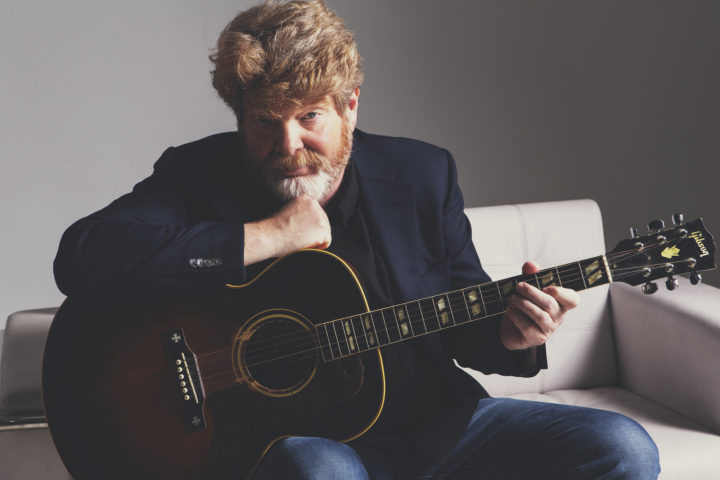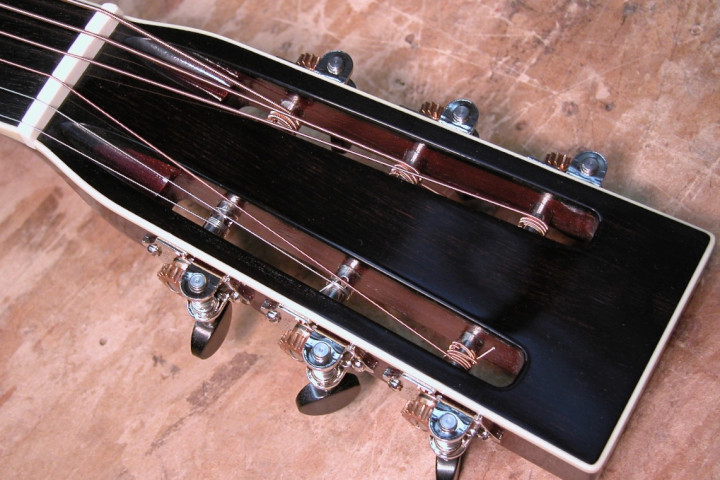We’re lucky enough to see a lot of gorgeous guitars around these parts… incredible handmade instruments revealing the most intricate levels of woodworking imaginable. Once in a while, our eyes must blur up from all that beauty, because the instrument that stopped us in our tracks this week was made Bozo Cardozo of Rainy Day Guitar Works… on a 3D printer. At first glance, it’s blue, it’s half-mandolin, half-guitar, it’s mostly plastic, and has it has fan frets. It doesn’t even have a name yet. We had to hear more about it.
Bozo is a guy who keeps a low-profile: No social presence, no website. We found out about him through fellow luthier/friend Fletcher Brock, who has this instrument on loan (and sung its praises). As it turns out, Bozo has been building all sorts of stuff around the environs of Sun Valley, Idaho for years. When he’s not in his workshop, he can be found floating down rivers or skiing down untracked slopes (he’s a professional heli-ski guide in the winter). We caught up with him in the dead of winter while he was stuck at home, recovering from a bought of Lyme disease.
Fretboard Journal: I don’t know a lot about you. Fletcher Brock sent me some pictures of your latest instrument, but I’m guessing there were many iterations that led up to that. Can you get us up to speed on who you are?
Bozo Cardozo: I am Bozo Cardozo and I live in Ketchum, Idaho. I run a company called Rainy Day Guitar Works, but I don’t build guitars. I started off building guitars. I went to Charles Fox’s School of Research and Design back in 1980. That was a six week intensive course. I built a handful of instruments back here in Idaho and immediately realized I was going to starve. So, I became a general woodworker. I’ve built all kinds of crazy stuff: Helical stairs, all kinds of weird furniture, lots parts for shops that they couldn’t do… whether it was carving or lathe work or bent or veneer or whatever. Problem solving is what makes my small shop unique.
FJ: You’re also an avid skier and kayaker?
BC: Yeah. I paddled a lot of the kid. I love to go racing and I’ve continued that through a lifetime. This time of year, I usually would not be in my shop; I’ve been [ski] guiding for 30-some odd years. My whole life has been focused on and having my winters freed up to be able to ski for a living.
This is the first time – because of the tick – that I ain’t skiing. But it’s okay. I’ve done more than an unimaginable amount of powder skiing in my life.
FJ: I read that you’re actually a heli-ski guide. You’re not messing around.
BC: I’ve been guiding since 1984, here, in Alaska, Greenland, and Chile.
FJ: And then you come home during the off season and dabble in musical instruments? Fletcher told me that you had made a collapsible travel guitar at one point.
BC: Yeah, I built an instrument that you loosened the strings on. The strings were captured by a bar at the bridge that then would come loose and then the neck would come off. I had a friend who wanted one and I’d always envisioned making it. This is relevant to your story, because in order to prototype parts for it, I bought an early desktop 3D printer. It was a terrible printer. I spent way more time trying to upgrade the printer than I got useful prints off of it, but it did allow me to come up with latch systems and track systems.
I’d been into the digital design world for about four or five years at that point. So, I was able to produce my own models to make my own parts for this instrument. I have now built four of those. They are full-scale length, short body, but a little bit bigger than a 00 at the lower bout. And they’re very real. There is no compromise: If you showed up and played this with somebody, it’s a totally viable instrument.
FJ: So, this new creation: It’s kind of a fanned-fret hybrid between a mandolin and a guitar?
BC: That is correct. This came about because even though I had a mandolin that I had built and have played a lot, I have never been steeped in mandolin players. Fletcher and I had the good luck to be able to do a Main Salmon River trip with Tim O’Brien, Joe K. Walsh, Ben Winship out of Teton Valley, Eli West, and then Thomas Sneed… just a phenomenal group of musicians.
After watching these guys play, I realized that many of the chords they were playing were just inversions of what you would play on a guitar below the G string, and that the guitar and the mandolin share that G. If you were to continue in fifths from the G string up, you would have a mirror of what happens from the G string down.
So, if the instrument is tuned from the lowest string, E, A, D, G, going up from there, G, D, A, E… just like the mandolin so that it’s a very symmetrical instrument. It’s tuned in fourths up to the G and fifths above that, but there’s some really interesting things that come from that mirroring.
Watching these guys play, I got the idea. I had shoulder reconstruction the next spring, so I had a lot of time to use just my right hand. I modeled up a fingerboard, printed it up and glued it to a piece of scrap alder, and one-handed, kind of hacked out this neck and drilled the holes for tuners. As my shoulder got better, I was able to start playing it and thought, “This is kind of interesting.”
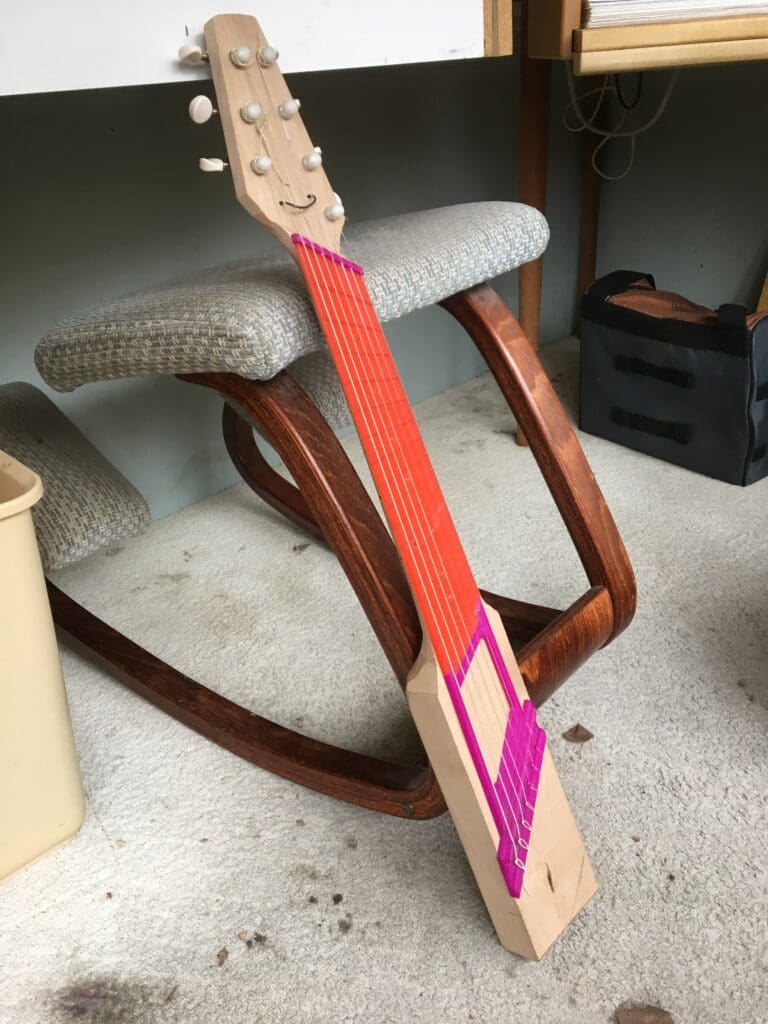
It does work. Then, when I got kicked out of Alaska in late March 2020 because of COVID, I came home and my wife said, “You need to live in the little guest house.” I just went deep down the rabbit hole.
FJ: You got thrown out of your own house?
BC: Well, in a sense. I’d been traveling and COVID was rampant here in Ketchum, [Idaho]. I just dove deep into my software and thought, “I’m going to make this thing.” I’d already played with some body shapes, but I knew I was hours and hours from having a workable, printable part. So, yes, this is a COVID instrument.
FJ: How big is your actual 3D printer and how many pieces make up this instrument?
BC: My printer prints 8″x10″ long by 8″ high. It’s not a giant printer by modern standards. Let me count up the parts here. There are basically 14 parts and then I print the nut and I print all the saddles. It’s 140 hours, roughly, of printer running time. So far, the top is screwed to the instrument, because when I first did the design I was sure that my first top was going to be a throwaway, and it was. Then I figured out a very different way to construct it.
FJ: I don’t know much about 3D printing, but I know there are different filaments you can buy. Do some lend themselves better to a musical instrument than others?
BC: Definitely. This instrument is made out of plastic, based on starch. It’s called PLA. The generic term is “corn plastic,” because when you run it to your printer, it smells slightly sweet, slightly organic. It’s nice because it’s not a petrochemical to start with. I think the starch is all throw away from industrial starch and, in theory, it breaks down faster. As a side note, I have some buried all over in different places in the woods around my house. So far, none of it has done a thing! It all just looks like it looked.
PLA is unfortunately temperature sensitive, so if it gets out in the hot sun, it’ll get soft, but at room temperatures, it is harder and more brittle than many of the other plastics that are available for 3D printing. The material I’m using for the top, and for all of the in-fill – inside of the outside skins of the body – is a PLA that has a very short length of carbon fiber in it.
And the carbon fiber does absolutely nothing for strength, but it does make it harder. From a builder’s standpoint, it has a better ring tone. If you tap on a piece of something made with this, then you go, “Wow. Okay. That has a little chime to it. I like that.” So, the top of the instrument is made of PLA with carbon fiber in it. It is made like a double top guitar top. There is an outside skin and an inside skin and then a lattice on the interior between them.
And that’s one of those things where you’re able to leverage the printer to make structures that would be difficult to make in wood, especially if there’s any curvature to them. The printer just doesn’t care. And the top is a little bit heavier than it would be if were made out of spruce. I did some testing until I had a square section of top that was as stiff as a piece of spruce deflection-wise, and it came in about 8 or 10% over what a piece of spruce would. So, it’s performing close-ish to our favorite beloved spruce material.
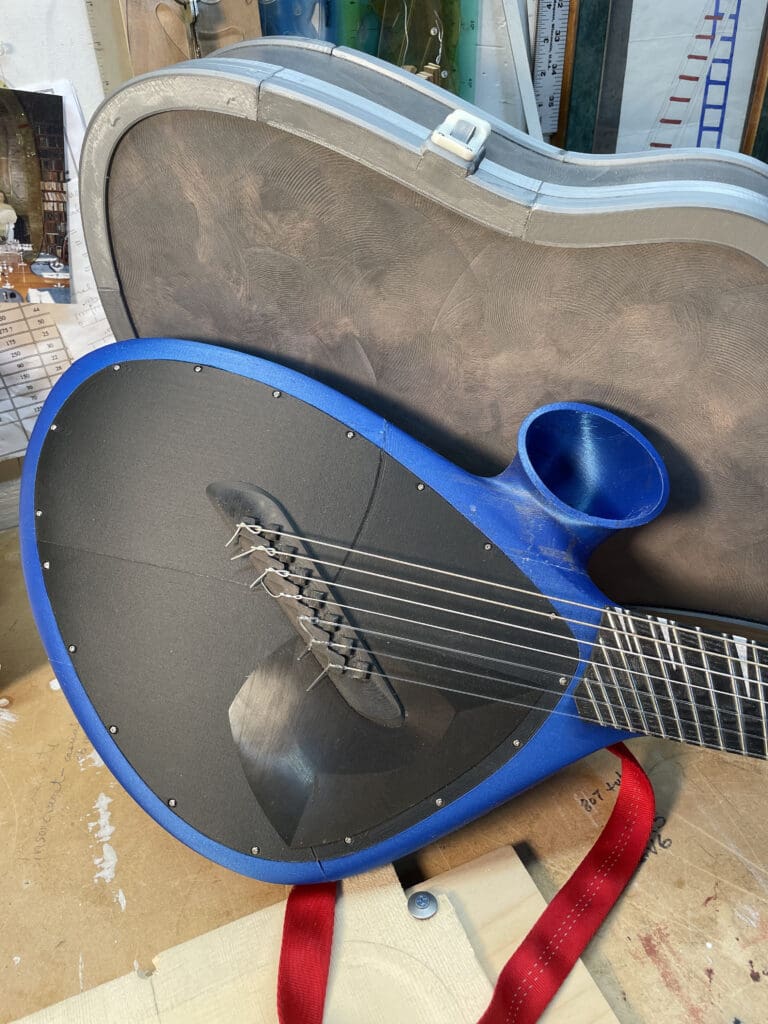
FJ: As long as it’s at room temperature?
BC: Yes. As long as you don’t stick it in your kayak, leave it in the hot sun, and melt it like I did with one last summer… just hilarious.
FJ: Does the carbon fiber and sandwich construction mean that you don’t really have what we’d think of as bracing?
BC: There’s no bracing. There is a little bit of a flange that you can’t see in order to give me a decent surface area to glue around all of the edges of the four pieces of the top. But, no, there is no bracing.
FJ: I can’t even wrap my head around a lot of this. You must be a computer whiz to be able to get this sort of three-dimensional image you had in your head into a file that the 3D printer would recognize?
BC: This instrument is built in a program called Fusion 360. It’s an Autodesk product. I don’t know what they really advertise it as, but it’s a really ideal product development program in that it has a crazy high ability as an engineering program and that you can simulate loads. You can ask it to generate structures for you. Everything can be built as an engineer would; you input a parameter and all you have to do to change the design… whether it’s whole sizes or scale lengths.
I am not an engineer, but this program is really made so that it’s accessible for somebody who is willing to dive into it. It shares a lot of the initial construction methods with [3D design software] SketchUp, which is an architectural program that I started using to model people’s homes – so they could see how various things in their houses were going to look – which has been a good chunk of my business the last 10 years. Clients who want to preview all that kind of stuff.
Am I a whiz with it? I don’t know that I’m a whiz. I build well in my head. I think that’s the first part. One of the features in Fusion is it allows you to do a kind of modeling that’s really organic and doesn’t have anything to do with numbers. You just keep pulling and stretching until you have something you like. And when you get a shape you like, you can then go through a couple of processes to turn it into a solid object or a thickened object. It knows what the math is.
FJ: I don’t know what to call it, but how did you come upon the sound port/sound hole? It almost looks like the horn coming out of an old Stroh violin.
BC: I was already so limited in what I could do soundhole-wise and so unsure of the structure that I didn’t want to mess with the top. I was pretty sure that getting decent low-end was going to be difficult out of a smallish box. So my solution was to just randomly make some kind of horn. It’s a longish port. At some point, I’ll cut the horn off, because I want to know how much it changes its tone. I’m assuming that, with the way speakers are designed, the longer your port is, the more able you are to make low tones. It has to be gaining something from that. If I were to build one in wood, I’m not quite sure how I would handle the soundhole.
FJ: Do you even want to build this instrument out of wood or is this 3D thing so intoxicating that you have no desire?
BC: It’s on my internal list to build a wood one. I want to be really clear about this: I am really unsure as to whether this is a viable instrument. It’s really fun. It’s great to sit on the couch and noodle around on. It’s not super loud. It can’t keep up with a D-18 or a banjo, but nylon strings suit it well. I have strung one with steel strings and that’s definitely not happening.
There’s a mechanical issue in terms of strings… and the strings that are available are all designed and intended for the common instruments we have. We’re asking a lot of these strings to produce, in pitch, tones and have an even string tension across a two and a half inch change in string length: The high E is a nylon string strung really close to its breaking point, the G, unfortunately, has less string tension. I’ve tried a wound string on there. I can get it to work for an hour and then it fails. I don’t think I’ll talk any string manufacturers into making custom strings for this to get the string balance equal across the whole instrument, though that would be so nice.
FJ: What are the four bass strings anyhow?
BC: They are silk, standard nylon strings, pulled from a 10-string set, so that I get the largest possible diameter: It measures out at 54 or 53, and goes down from there.
FJ: It’s all from one 10-string guitar set?
BC: Yes.
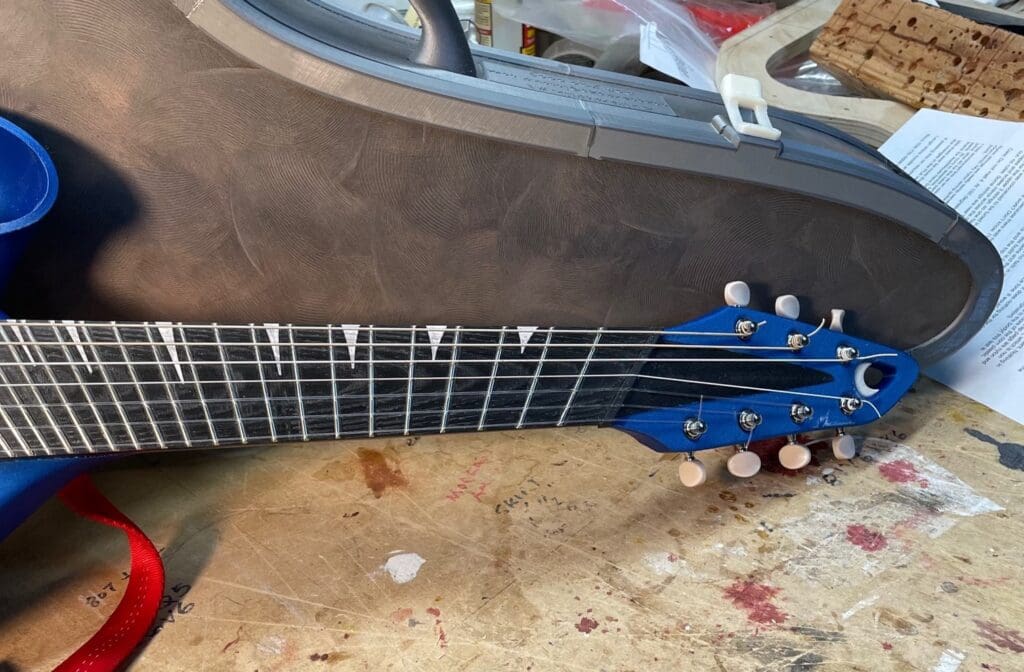
FJ: Is the neck made of wood?
BC: The neck is printed. But it has a really substantial piece of manufactured, square stock carbon in it, in order to be stiff enough because the string tension is remarkably high.
FJ: Was there a lot of trial and error in figuring out the fanned frets spacing for this scale?
BC: No. That was just based on what was the longest, high E string I could make and what was the shortest low E string I could make. I just took a scrap piece of wood … a really crude device, a couple of tuners screwed to it and went through a couple sets of strings trying to find just how long could I make that high E. I thought it was going to be steel and it turned out that nylon was the one that I could bring up to pitch.
FJ: You said it takes 100-plus hours for the 3D printer to do its magic. After that, is it complicated on your end to put all the pieces together?
BC: No, not really. But it’s not like you push the print button and, on a 24-hour print, absolutely nothing goes wrong every time. There are a lot of parts that get thrown away. Or I’ll say, “I don’t want to throw that away. Let me do some MacGyvering here,” and I’ll go in digitally and figure out roughly where the parts failed. I’ll clean it off, I’ll print a part that’s the remainder of the part that didn’t print and then I’ll glue it together. That rabbit hole becomes very consuming.
FJ: What’s holding the bridge to the guitar top?
BC: Some nice, industrial, acrylic glue… bad stuff.
FJ: I’m in awe of your creativity on this thing. Do you have any idea what you would charge if somebody were to commission one of these from you?
BC: I would build one for a grand. Realistically, there’s only 30 or 40 hours in construction time, assuming everything goes relatively well.
FJ: Can you change the color?
BC: Totally. This happens to be this kind of lovely blue with a little metal flake in it. You could go of the Proto-pasta website and pick out any color you wanted.
FJ: Do you have a website or do people just find you?
BC: I do not. I live in a resort town. I have run this business since 1982. I had 500 [business] cards made up then and I bet I gave 30 away. It’s all word of mouth. I’ve never wanted for work.
FJ: This was fun. I’m glad Fletcher Brock told me about your project.
BC: One other part of this whole thing is that I very much want to build just a printed nylon mandolin. As soon as I started printing. I have wanted travel guitars to be injection molded like the old Maccaferri’s and made really well, but so cheaply that they could be sold at Walmart for 300 bucks and any kid could have one… make an instrument out of plastic for the masses! The other part of that was, “Well, we’re finally getting to where we’re making decent filament out of recycled water bottles. Could I ever 3D print travel guitars?” They are printers big enough to do the bodies in one go now. Is that a rabbit hole I want to jump down?
It’s still deep in my head that, as the next 20 years pass and wood becomes even more of an issue than it is, and our acceptance of different ways of doing things changes – which the guitar world is crazy slow to adopt – some of this stuff that seems kind of a novelty may become actually a real thing.
We’ll never replace decent spruce and gorgeous Southern hemisphere materials. That stuff’s got life, but some of this stuff is going to creep in there. That’ll be interesting to see.
